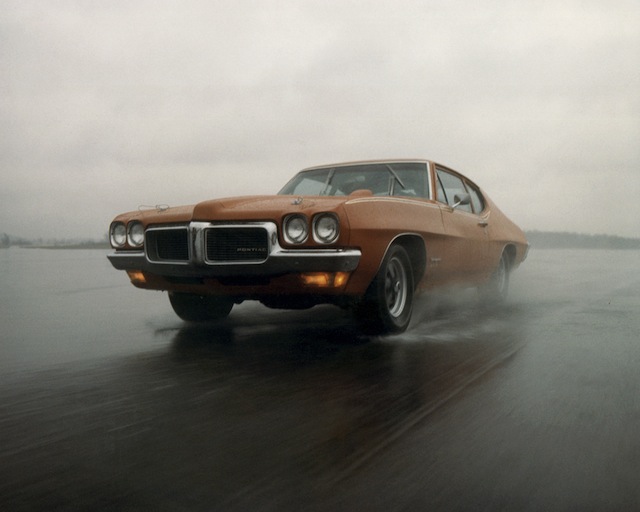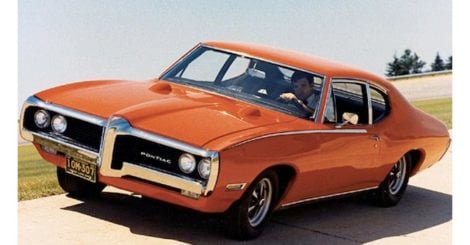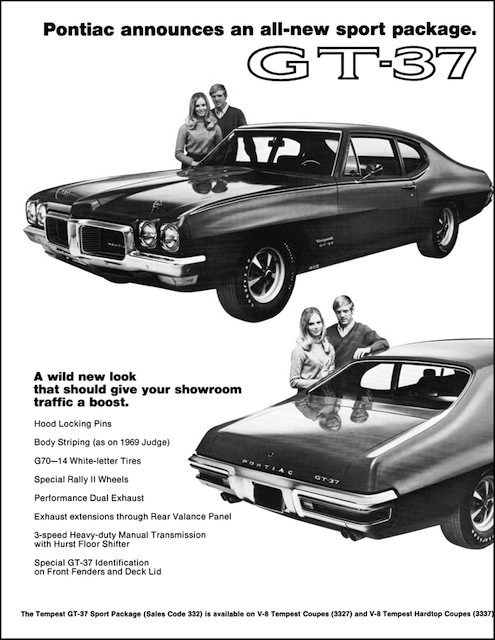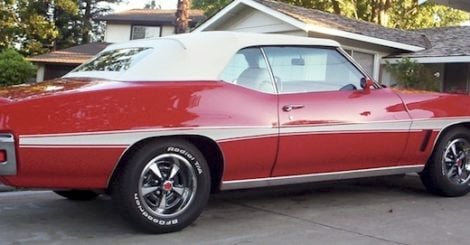When Plymouth introduced the Road Runner in the fall of 1967, it shook up the American performance car arena. By then the market was inundated with supercars with high trim levels…and prices to match. The Road Runner, on the other hand, gave wheels to the masses – a 14-second populist screamer for under $2900.
Pontiac got caught with their pants down. As the progenitor of the then-current performance car scene, Pontiac took over two model years to respond to the Road Runner. What they ended up producing has been surrounded by an enigma ever since: the GT-37.
The stillborn ET had an air induction system in the shell of the right-hand hood tach unit.
1967 had been a pivotal year for American performance for a number of reasons: the Camaro, Firebird, and Cougar gave the Mustang some competition, and the Chrysler Corporation finally debuted its “image” cars, the Plymouth GTX and Dodge Coronet R/T. By that time, cars like the Mopars and the GTO started around $3000 and, with options, were out of reach to the average kid who saved his pennies from bagging groceries after school.
Around the same time, Car and Driver magazine’s editor, Brock Yates, wrote about bringing the supercar back to basics with a taxicab interior, four-speed transmission (most cars had a standard three-speed at the time), and little else. Plymouth responded with the brilliant 1968 Road Runner, a post coupe with a standard 383, four-speed, and plenty of whimsy. Expecting sales of 2,000 units, Plymouth ended up building over 45,000 ‘Runners.
No one was more interested in the Road Runner’s success than John DeLorean. As the Big Kahuna at Pontiac, he was not happy considering the GTO had owned the market for four years running. He had his talented minions create a Wide-Track competitor to the Road Runner, which ended up being a Tempest post coupe with the 330-horsepower 350 HO motor, slash beltline stripe, cowl induction and hood tach, and bright paint. They named it ET (for “Elapsed Time”), but DeLorean wasn’t having a 350 in a 400 cid world. He had his people go back to the drawing board and, in an ironic twist, created a super-GTO and named it The Judge; this was the antithesis of the Road Runner’s raison d’etre.
However, Pontiac responded with the GT-37 package mid-year in 1970 and gave Pontiac fans the Road Runner competitor they were waiting for. But to understand the enigma of the GT-37, you first must learn about Pontiac’s 1970 lineup. The A-body hierarchy started with the Tempest, then continued with the LeMans, the new LeMans Sport, and GTO. Mid-year 1970, Pontiac introduced a special promotional model called Tempest T-37 that was touted as America’s lowest-priced mid-size hardtop (the regular Tempest was only available as a pillared coupe and sedan). It was this car that the GT-37 package was based, which consisted of the following:
- Hood locking pins
- Body striping (taken from the 1969 GTO Judge; optional on the 1970 GTO as code D98)
- G70-14 White-letter tires
- Rally II wheels
- Dual exhaust with rear valence exit
- Heavy-duty three-speed manual transmission with Hurst Floor Shifter
- Special GT-37 decals on front fenders and trunklid
By the time the GT-37 made its debut, the supercar market had started its decline. But in a smart move for Pontiac, they specified the standard motor to be a 350 with two-barrel carburetor kicking out 255 horsepower – hardly muscle, but it allowed the GT-37 to capture the emerging market for a car with sporting pretentions while being insurance-friendly. A tepid 400 two-barrel was a step up, but a 330-horse 400 was available for people who wanted to hunt Road Runners. All told, 1,419 GT-37s were built in the abbreviated model year.
Extremely rare dealer poster of the 1970-½ GT-37.
Due to the success of the T-37 hardtop (over 20,000 sold), Pontiac decided to put the Tempest model to rest for 1971 and have the T-37 represent the bottom rung of Pontiac A-body line, below the LeMans, LeMans Sport, and GTO. But the big news for 1971 was GM’s lowering the compression on all their engines. This reduced horsepower but also allowed the motors to run on low-lead or unleaded gas. Hence, the GTO’s standard 400 lost 50 horsepower to 300, while the optional 455 fell 35 to 325. However, Pontiac debuted the 455 HO, an evolution of 1969-70’s Ram Air IV 400. Round-port heads is what distinguished this motor from the others. Despite the lowered compression, Pontiac managed to give the 455 HO performance that exceeded the high-compression 455 from 1970 despite being rated 335 horsepower vs. 360.
Note the early' eyebrow stripes on this 1971 GT-37.
Likewise, the GT-37 package returned for 1971 and, like before, the 350-2 was standard plus the 400-2 and 400-4 optional. This time, however, the 455-4 and 455 HO were available. Advertised as a “GTO for kids under 30,” the GT-37 package included [6]:
- GTO exhaust system, with low-restriction split duals running through a steel rear valence panel
- Heavy-duty Muncie three-speed transmission with Hurst floor-mounted shifter
- Special Rally II wheels (dechromed, like The Judge’s)
- G70-14 bias-belted, white-lettered tires
- Hood locking pins
- Vinyl accent striping
- Body-colored mirrors
- GT-37 nameplates on the trunk and front fenders
1971-½ GT-37 with the sword stripe. Note the new-for-1971 Honeycomb wheels.
Aside of a slight facelift plus new engines and stripes, the GT-37 was the same as before. However, a mid-year stripe redesign replaced the two-tone eyebrow stripes (available in black/red or white/red, and also coded D98 [8] when optioned on standard GTOs [9]) with a full-width sword stripe (available in black, silver, blue, or gold [10]). With a full model year and a market pining for insurance-beaters, the 1971 GT-37 had a much better showing than 1970’s model with 5,802 built. Considering GTO production fell by 75% from 1970, it could be inferred the GT-37 cannibalized GTO sales. However, only 641 GT-37s were built with the same engines as the GTO:
- 350-2 5,015 units
- 400-2 146 units
- 400-4 572 units
- 455-4 15 units
- 455 HO 54 units
The GT-37 didn’t return for 1972, but neither did the T-37. The LeMans now became the base A-body, and the Luxury LeMans became the new top-line model. However, a new LeMans GT package was created in the spirit of the GT-37. It was very similar in appearance to the GT-37 – sword stripe and all – but now was also available as a convertible. It was a bigger success at 8,880 built.
1972 LeMans GT convertible. This car has a reproduction ducktail spoiler, of which only 2 were built before the option was cancelled. Also note the 'GT' inscription on the front fender.
Over the years, the T-37 and GT-37 has confused plenty of people – both Pontiac folks and Brand X – despite decent promotion at the time. Let’s address some of the issues that have kept this car an enigma:
- Where did the T-37 name come from? The best that can be determined is that Pontiac used “T” for Tempest and “37” for GM’s body code for hardtop coupe. Sounds strange, but is there a better explanation?
- In more recent years, the T-37 has been touted as being a performance model, but only the GT-37 had performance pretentions. It’s likely that the precious few T-37s ordered with the 455 [12] that have appeared in magazines may have influenced this incorrect thinking.
- The GT-37 package in 1970-½ was available on either the Tempest T-37 hardtop coupe or the Tempest post coupe. Literature from 1971 stated the package was again available on both the hardtop and post coupe, but only GT-37 hardtops were built that year.
- Thirty years ago, Pontiac’s official historian, John Sawruk [13], stated that the 400/330 as available on the 1970-½ GT-37 was the same motor as the Ram Air III available the GTO but without the air induction equipment. However, as more of these rare cars have popped up, it’s become apparent from the engine codes that the motor was the same 400/350 that was standard in the GTO. In an even stranger twist, this was only true for cars ordered with a three- or four-speed manual; a 400-4 and automatic gave you the small-valve motor that was used on the Catalina. Why Pontiac did this is anyone’s guess.
- No road test exists of any 1970-½ GT-37 but John Sawruk claimed that a silver Tempest with a 400 and stick was tested at GM’s proving grounds and was faster than the vaunted Ram Air IV GTO. However, Pontiac Historical Services [14] can find no record of the car.
After 1972, the LeMans GT continued on as a handling an appearance package but, by that time, the market had switched its focus on sporty luxury like the Grand Prix. The LeMans GT [15] was no more when the LeMans was redesigned for 1978.






